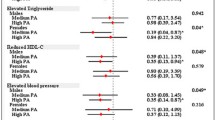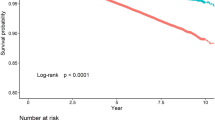Abstract
Parallel to the increase in obesity, the prevalence of metabolic syndrome (MetS) is continually increasing, with increased risk of diabetes and cardiovascular atherosclerosis diseases. Despite the importance of this public health problem, the relative impact of diet and physical activity on MetS prevalence has yet to be established. We investigated the association between lifestyle, in terms of both habitual dietary pattern and physical activity, and MetS in a cohort of adults without known diabetes and atherosclerotic cardiovascular disease. Four hundred seventy-seven randomly selected adult participants were cross-sectionally investigated. Each participant answered a food frequency questionnaire and a questionnaire on physical activity, and underwent routine laboratory blood measurements. MetS was identified in 24.7 % of the cohort. Dietary patterns were not significantly different (P = 0.31) between the groups (with or without MetS). The habitual physical activity level was significantly lower (P = 0.011) in the group with MetS. In particular, the prevalence of sedentary participants was 58.1 % in the group with MetS, and 43.9 % in the group without MetS. Multivariate analysis revealed that MetS was associated with age (OR = 1.06, 95 % CI 1.03–1.08) and physical activity level (light vs. sedentary: OR = 0.53, 95 % CI 0.32–0.87; moderate/heavy vs. sedentary: OR = 0.31, 95 % CI 0.13–0.75). This study suggests that inadequate physical activity level is associated with MetS. Our results are therefore consonant with the notion of healthier lifestyle changes to counteract the epidemic of diabetes and cardiovascular disease, though adequate interventional trials will be needed in high-risk populations.

Similar content being viewed by others
References
Grundy SM (2012) Pre-diabetes, metabolic syndrome, and cardiovascular risk. J Am Coll Cardiol 2012(59):635–643
Gu D, Reynolds K, Wu X, Chen J, Duan X, Reynolds RF, Whelton PK, He J (2005) Prevalence of the metabolic syndrome and overweight among adults in China. Lancet 365:1398–1405
Ford ES, Giles WH, Mokdad AH (2004) Increasing prevalence of the metabolic syndrome among US adults. Diabetes Care 27:2444–2449
Ignarro LJ, Balestrieri ML, Napoli C (2007) Nutrition, physical activity and cardiovascular disease: an update. Cardiovasc Res 73:326–340
Esmaillzadeh A, Kimiagar M, Mehrabi Y, Azadbakht L, Hu FB, Willett WC (2007) Dietary patterns, insulin resistance, and prevalence of the metabolic syndrome in women. Am J Clin Nutr 85:910–918
Cho YA, Kim J, Cho ER, Shin A (2011) Dietary patterns and the prevalence of metabolic syndrome in Korean women. Nutr Metab Cardiovasc Dis 21:893–900
Wirfalt E, Hedblad B, Gullberg B, Mattisson I, Andren C, Rosander U, Janzon L, Berglund G (2001) Food patterns and components of metabolic syndrome in men and women: a cross-sectional study within the Malmo Diet and Cancer Cohort. Am J Epidemiol 154:1150–1159
Sonnenberg L, Pencina M, Kimokoti R, Quatromoni P, Nam BH, D’Agostino R, Meigs JB, Ordovas J, Cobain M, Millen B (2005) Dietary patterns and the metabolic syndrome in obese and non-obese Framingham women. Obes Res 13:152–162
Panagiotakos DB, Pitsavos C, Chrysohoou C, Skoumas J, Tousoulis D, Toutouza M, Toutouzas P, Stefanadis C (2004) Impact of lifestyle habits on the prevalence of the metabolic syndrome among Greek adults from the ATTICA study. Am Heart J 147:106–112
Lutsey PL, Steffen LM, Stevens J (2008) Dietary intake and the development of the metabolic syndrome: the Atherosclerosis Risk in Communities study. Circulation 117:754–761
Denova-Gutierrez E, Castanon S, Talavera JO, Gallegos-Carrillo K, Flores M, Dosamantes-Carrasco D, Willett WC, Salmeron J (2010) Dietary patterns are associated with metabolic syndrome in an urban Mexican population. J Nutr 140:1855–1863
Amini M, Esmaillzadeh A, Shafaeizadeh S, Behrooz J, Zare M (2010) Relationship between major dietary patterns and metabolic syndrome among individuals with impaired glucose tolerance. Nutrition 26:986–992
Buscemi S, Nicolucci A, Mattina A, Rosafio G, Massenti FM, Lucisano G, Galvano F, Amodio E, Pellegrini F, Barile AM, Maniaci VM, Grosso G, Verga S, Sprini D, Rini GB (2013) Relation between dietary patterns on insulin resistance and clinically silent carotid atherosclerosis in apparently healthy people. Eur J Clin Nutr 67:1284–1290
Ford ES, Kohl HW, Mokdad AH, Ajani UA (2005) Sedentary behavior, physical activity, and the metabolic syndrome among US adults. Obes Res 13:608–614
Dunstan DW, Salmon J, Owen N, Armstrong T, Zimmet PZ, Welborn TA, Cameron AJ, Dwyer T, Jolley D, Shaw JE (2005) Associations of TV viewing and physical activity with the metabolic syndrome in Australian adults. Diabetologia 48:2254–2261
Kim J, Tanabe K, Yokoyama N, Zempo H, Kuno S (2013) Objectively measured light-intensity lifestyle activity and sedentary time are independently associated with metabolic syndrome: a cross-sectional study of Japanese adults. Int J Behav Nutr Phys Act 10:30
Bo S, Ciccone G, Guidi S, Gambino R, Durazzo M, Gentile L, Cassader M, Cavallo-Perin P, Pagano G (2008) Diet or exercise: what is more effective in preventing or reducing metabolic alterations? Eur J Endocrinol 159:685–691
Stewart KJ, Bacher AC, Turner K, Lim JG, Hees PS, Shapiro EP, Tayback M, Ouyang P (2005) Exercise and risk factors associated with metabolic syndrome in older adults. Am J Prev Med 28:9–18
Willett W (1998) Nutrition epidemiology, 2nd edn. Oxford University Press, New York
Alberti KGMM, Eckel RH, Grundy SM, Zimmet PZ, Cleeman JI, Donato KA, Fruchart JC, James WPT, Loria KM, Smith SC (2009) Harmonizing the metabolic syndrome. Circulation 120:1640–1645
The expert committee on the Diagnosis and Classification of Diabetes Mellitus (2006) Report of the Expert Committee on the diagnosis and classification of diabetes mellitus. Diabetes Care 26(Suppl 1):5–20
Buscemi S, Batsis JA, Verga S, Carciola T, Mattina A, Citarda S, Re A, Arnone M, D’Orio L, Belmonte S, D’Angelo A, Cerasola G (2011) Long-term effects of a multidisciplinary treatment of uncomplicated obesity on carotid intima-media thickness. Obesity 19:1187–1192
Friedewald WT (1972) Estimation of the concentration of low density lipoprotein cholesterol in plasma, without use of the preparative ultracentrifuge. Clin Chem 18:499–502
Rule AD, Larson TS, Bergstralh EJ, Slezak JM, Jacobsen SJ, Cosio FG (2004) Using serum creatinine to estimate glomerular filtration rate: accuracy in good health and in chronic kidney disease. Ann Intern Med 21:929–937
Matthews DR, Hosker JP, Rudenski AS, Naylor BA, Treacher DF, Turner RC (1985) Homeostasis model assessment: insulin resistance and b-cell function from fasting plasma glucose and insulin concentrations in man. Diabetologia 28:412–419
Katz A, Nambi SS, Mather K, Baron AD, Follmann DA, Sullivan G, Quon MJ (2000) Quantitative insulin sensitivity check index: a simple, accurate method for assessing insulin sensitivity in humans. J Clin Endocrinol Metab 85:2402–2410
Kastorini CM, Milionis HJ, Esposito K, Giugliano D, Goudevenos JA, Panagiotakos DB (2011) The effect of Mediterranean diet on metabolic syndrome and its components: a meta-analysis of 50 studies and 534,906 individuals. J Am Coll Cardiol 57:1299–1313
Buscemi S, Verga S, Donatelli M, D’Orio L, Mattina A, Tranchina MR, Pizzo G, Mulè G, Cerasola G (2009) A low reported energy intake is associated with metabolic syndrome. J Endocrinol Invest 32:538–541
Irwin ML, Ainsworth BE, Mayer-Davis EJ, Addy CL, Pate RR, Durstine JL (2002) Physical activity and the metabolic syndrome in a tri-ethnic sample of women. Obes Res 10:1030–1037
Lakka TA, Laaksonen DE, Lakka HM, Mannikko N, Niskanen LK, Rauramaa R, Salonen JT (2003) Sedentary lifestyle, poor cardiorespiratory fitness, and the metabolic syndrome. Med Sci Sports Exerc 35:1279–1286
Vaughan C, Schoo A, Janus ED, Philpot B, Davis-Lameloise N, Lo SK, Laatikainen T, Vartiainen E, Dunbar JA (2009) The association of levels of physical activity with metabolic syndrome in rural Australian adults. BMC Public Health 9:273
Lee DH, Kim YM, Jekal Y, Park S, Kim KC, Naruse M, Kim SH, Kim SH, Park JH, Lee MK, Chu SH, Jeon JY (2013) Low levels of physical activity are associated with increased metabolic syndrome risk factors in Korean adults. Diabetes Metab J 37:132–139
Laaksonen DE, Lakka HM, Salonen JT, Niskanen LK, Rauramaa R, Lakka TA (2002) Low levels of leisure-time physical activity and cardiorespiratory fitness predict development of the metabolic syndrome. Diabetes Care 25:1612–1618
Palaniappan L, Carnethon MR, Wang Y, Hanley AJ, Fortmann SP, Haffner SM, Wagenknecht L (2004) Predictors of the incident metabolic syndrome in adults: the Insulin Resistance Atherosclerosis Study. Diabetes Care 27:788–793
LaMonte MJ, Barlow CE, Jurca R, Kampert JB, Church TS, Blair SN (2005) Cardiorespiratory fitness is inversely associated with the incidence of metabolic syndrome. A prospective study of men and women. Circulation 112:505–512
Trojani M, Palmieri L, Vanuzzo D, Donfrancesco C, Panico S, Pilotto L, Dima F, Lo Noce C, Caiola Pde S, Giannuzzi P, Giampaoli S (2006) Occupational and leisure time physical activity: trend in the Italian population. G Ital Cardiol 7:487–497
Barengo NC, Nissinen A, Tuomilehto J, Pekkarinen H (2002) Twenty-five-year trends in physical activity of 30- to 59-year-old populations in eastern Finland. Med Sci Sports Exerc 34:1302–1307
Westerståhl M, Barnekow-Bergkvist M, Hedberg G, Jansson E (2003) Secular trends in sports: participation and attitudes among adolescents in Sweden from 1974 to 1995. Acta Paediatr 92:602–609
Anderssen N, Jacobs DR Jr, Sidney S, Bild DE, Sternfeld B, Slattery ML, Hannan P (1996) Change and secular trends in physical activity patterns in young adults: a seven-year longitudinal follow-up in the Coronary Artery Risk Development in Young Adults Study (CARDIA). Am J Epidemiol 143:351–362
Crespo CJ, Keteyian SJ, Heath GW, Sempos CT (1996) Leisure-time physical activity among US adults. Results from the Third National Health and Nutrition Examination Survey. Arch Intern Med 156:93–98
Helmrich SP, Ragland DR, Leung RW, Paffenbarger RS (1991) Physical activity and reduced occurrence of non-insulin-dependent diabetes mellitus. N Engl J Med 325:147–152
Hu FB, Leitzmann MF, Stampfer MJ, Colditz GA, Willett WC, Rimm EB (2001) Physical activity and television watching in relation to risk for type 2 diabetes mellitus in men. Arch Intern Med 161:1542–1548
Gidlow C, Johnston LH, Crone D, Ellis N, James D (2006) A systematic review of the relationship between socio-economic position and physical activity. Health Educ J 65:338–367
Buscemi S, Verga S, Caimi G, Cerasola G (2007) A low resting metabolic rate is associated with metabolic syndrome. Clin Nutr 26:806–809
Knowler WC, Fowler SE, Hamman RF, Christophi CA, Hoffman HJ, Brenneman AT, Brown-Friday JO, Goldberg R, Venditti E, Nathan DM (2009) 10-year follow-up of diabetes incidence and weight loss in the Diabetes Prevention Program Outcomes Study. Lancet 374:1677–1686
Holtermann A, Marott JL, Gyntelberg F, Søgaard K, Suadicani P, Mortensen OS, Prescott E, Schnohr P (2012) Occupational and leisure time physical activity: risk of all-cause mortality and myocardial infarction in the Copenhagen City Heart Study. A prospective cohort study. BMJ Open 2(1):e000556. doi:10.1136/bmjopen-2011-000556
Mariani S, Fiore D, Barbaro G, Basciani S, Saponara M, D’Arcangelo E, Ulisse S, Moretti C, Fabbri A, Gnessi L (2013) Association of epicardial fat thickness with the severity of obstructive sleep apnea in obese patients. Int J Cardiol 167:2244–2249
Lubrano C, Saponara M, Barbaro G, Specchia P, Addessi E, Costantini D, Tenuta M, Di Lorenzo G, Genovesi G, Donini LM, Lenzi A, Gnessi L (2012) Relationships between body fat distribution, epicardial fat and obstructive sleep apnea in obese patients with and without metabolic syndrome. PLoS One 7:e47059
Acknowledgments
The authors would like to thank Warren Blumberg for his help in editing this paper.
Conflict of interest
On behalf of all authors, the corresponding author states that there is no conflict of interest.
Author information
Authors and Affiliations
Corresponding author
Rights and permissions
About this article
Cite this article
Buscemi, S., Sprini, D., Grosso, G. et al. Impact of lifestyle on metabolic syndrome in apparently healthy people. Eat Weight Disord 19, 225–232 (2014). https://doi.org/10.1007/s40519-014-0117-4
Received:
Accepted:
Published:
Issue Date:
DOI: https://doi.org/10.1007/s40519-014-0117-4




